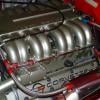I have often thought that the "requirement" for these single phase hoists to be on a 15amp cct is maybe more about having them on a dedicated circuit?
Maybe to assist in owner complaints of nuiscance tripping etc. i.e. make it easier for the vendor when dealing with warranty type issues ?
My thoughts are due to -
1.
It's nearly impossible to use them "continuously", as they only normally "work" in the hoisting operation, and just use gravity for the lowering operation.
A typical hoisting operation seems about the same time as a gravity lowering operation. Thus a 50% duty cycle would be max?
2.
We have 2 single phase units, a 2 post and a 4 post, neither of the motors have a full load current stated as being in excess of 12 amps. Sure there is some inrush current, but that applies to most motors hooked up to 240v.
3.
Even with a large 4wd on ours, the running / hoisting current never even gets near 10amps. ( more like 6 or 7 amps.)
Not for me to suggest anyone disregards the manufacturer/ vendor's requirements.
Happy to be corrected.
I have seen quite a few electrical installations over the years that in technical terms were wired according to the rules.
However, in terms of being useable or fit for purpose they left a lot to be desired.
New rules means that the limitations on the number of outlets on a circuit are all but gone.
Instead, the rating of the breaker protects the installation.
Cant keep increasing the fuse size as used to happen all too frequently in years gone by.
And with trades being screwed on price by builders more and more, the trades will find the cheapest way to get the required number of outlets.
I stopped doing domestic work as much as possible a very long time ago.
Any jobs I did do, were done to my standards and pricing.
Didnt care that I didnt win many jobs on price.
But loved listening to the tales of woe when a cheaper job won, and the owners werent happy with the lack of ability to use what they wanted to.
Cheers
Rob




 View Garage
View Garage


















